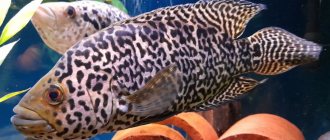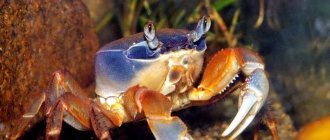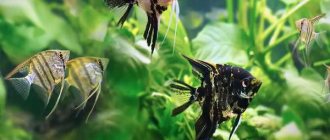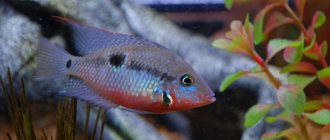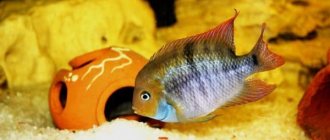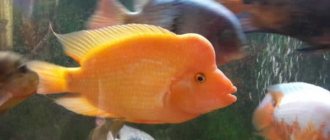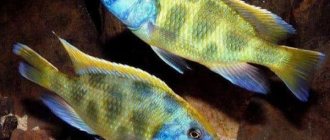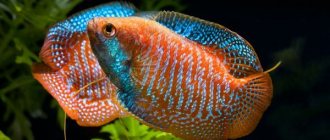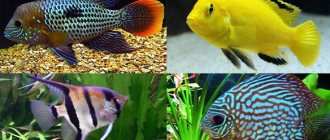Habitat
Endemic to two lakes Nicaragua and Managua, located in the territory of modern Nicaragua in Central America. Both lakes are of tectonic origin, connected by the Tipitapa River. Cichlazoma labiatum prefers to stay along rocky shores, where it swims among crevices. Note - lake
Nicaragua is the largest freshwater lake in Latin America and the only one in the world where sharks are found. Brief information:
- Aquarium volume - from 350 l.
- Temperature - 21–26°C
- pH value – 6.0–8.0
- Water hardness - from soft to hard (5–26 dGH)
- Substrate type - rocky
- Lighting - moderate
- Brackish water - no
- Water movement - weak to moderate
- The size of the fish is 30–35 cm.
- Food - any
- Temperament - aggressive
- Keeping alone in a species aquarium
Compatibility with other fish
Compatible
If you want to take care of your Red Devil Cichlid, be prepared to keep a single fish tank. Because of their aggression, they stay alone.
The only known way to successfully and safely keep red devils with other fish is to keep them in a large aquarium with plenty of caves and hiding places. Although this also does not guarantee the safety of other fish.
The good news is that Cichlasum labiatum can be kept in pairs. These fish are monogamous, so you can keep males and females together.
Not compatible
Red devils are not compatible with all types of fish due to their aggression. No matter how many fish you place in the aquarium, they will soon be eaten.
Maintenance and care, arrangement of aquariums
One adult fish will require an aquarium of 350 liters. The decoration mainly uses fragments of rocks, large stones, and gravel substrate. There is no need for live plants; artificial ones can be used if desired. All interior decor must be securely fastened, and the equipment must be hidden, if possible, so that such a large fish cannot damage anything. The aquarium is equipped with a reliable lid. Despite its size, the Red Devil is able to jump out of it. Water parameters have wide acceptable ranges of pH and dGH values, so there are no problems with water treatment. Difficulties are associated only with maintaining high water quality. Filtration and aeration systems are installed based on the need to process large masses of organic waste and the need of fish for a high content of dissolved oxygen. It is mandatory to replace part of the water (20–25% of the volume) with fresh water weekly.
Content
— Advertising —
Cichlazomas labiatum are hardy and not fussy to keep. However, due to their aggressiveness, the fish are best kept by experienced aquarists. Red devils tolerate a variety of water conditions. However, they will not live long and remain in good health if they are not taken care of.
Requirements for an aquarium
- For one fish, the size of the aquarium must be at least 200 liters. For a couple - at least 450 liters.
- Place sand at the bottom of the aquarium. These fish are diggers. Gravel or hard substrate will only cause damage.
- It is not recommended to plant plants. Red devils are known for destroying any vegetation.
- Place a lot of decor in the aquarium where individuals can hide: stones, driftwood, decorative caves.
- Provide your aquarium with a filtration system.
Water requirement
- Water temperature: 24-26°C.
- pH level: 6.5-7.5.
- Water hardness: 6-25 dGH.
Do not forget to change the water by 15-20% once a week to prevent diseases. Poor water quality causes a reduction in life expectancy.
What to feed?
Red devils are omnivorous fish and will eat almost anything you throw in their tank. Although many people think that they are predators due to their aggressive behavior.
Feed your fish earthworms, crickets, and spirulina-based food. Provide variety so that individuals receive all the necessary nutrients and vitamins during feeding.
Breeding/reproduction
The process of breeding the Red Devil is quite simple. When the mating season comes, the fish will do everything themselves, without the need to create any special conditions or introduce a special diet in advance. The main difficulty is that the fish are not compatible with each other and in a home aquarium it is extremely difficult to get a pair ready for reproduction. Cichlasoma labiatum is often kept alone due to its large size and aggressive behavior, and if a male is placed in the same tank with a female, she will soon be killed. There are several ways to obtain offspring in an artificial environment, but none of them gives a 100% guarantee. First. A male and a female from different aquariums are placed in one and separated by a transparent perforated wall. There is a small chance that after a few weeks the male will get used to it and reduce the degree of aggression, and in the future they will be able to form a temporary pair. Second. Initially, about 6 young individuals are acquired, which will grow in place. As they grow older, one pair can naturally form, which in the future will regularly produce offspring. The chances of forming a pair increase in proportion to the increase in the number of young fish growing together, but this is not the case in amateur aquarium keeping. As a result, it is better to buy this species from professional breeders than to breed it yourself.
Cichlasoma Labiatum or Red Devil Cichlid. Contents of Cichlazoma labiatum.
Cichlasoma Labiatum (lat. Cichlasoma labiatum or Amphilophus Labiatus), which in the West is called the Red Devil Cichlid or Lipped Cichlid, comes to us from Central America, namely from Lake Nicaragua. Red Devil is perhaps one of the most appropriate common names for this fish, as it has a very aggressive behavior. If you are looking...
Cichlasoma Labiatum (lat. Cichlasoma labiatum or Amphilophus Labiatus), which in the West is called Devil Cichlid or Lipped Cichlid , comes to us from Central America, namely from Lake Nicaragua. Red Devil is perhaps one of the most appropriate common names for this fish, as it has a very aggressive behavior. If you are looking for a fish that will terrorize almost any fish in the aquarium, then buy a Red Devil Cichlid!
Cichlazomas Labiatum have many color variations, the basis of which is red and white and their shades. Perhaps this diversity is the result of crossing with other cichlids.
Cichlazomas Labiatum are one of the fish that love to customize the aquarium for themselves. For example, they love to dig up and uproot plants, so most likely you will have to remove all plants (both live and artificial) from the aquarium. When Cichlazomas Labiatum are not attacking other fish in the aquarium, they most often retire to a quiet cave that they consider their own. And all this (uprooting plants, digging up soil, attacking fish and resting in a shelter) happens every day. It follows from this that it is better not to keep them in common aquariums with smaller or less aggressive fish. Experts recommend keeping them alone or as a mating pair in a large aquarium.
Cichlazoma Labiatum is not picky about food. She will eat almost anything you offer her, including cichlid flakes and pellets, frozen food, worms, crickets, and other live foods. When feeding the Lipped Cichlasoma with live food fish, be careful not to introduce any disease into the aquarium. Try to provide her with a balanced diet with a wide variety of foods.
Males of Cichlazoma labiatum are larger than females of the same age. They may also develop a nuchal hump on their head. Propagating them is relatively easy, provided that the male and female get along with each other. They spawn on flat rock and will be good parents, guarding the eggs and fry until they can swim freely.
Cichlazoma Labiatum - photo.
Reproduction of Cichlazoma Labiatum - video.
Cichlazoma Labiatum - contents.
Scientific name: Amphilophus labiatus.
Other names: Red Devil Cichlid, Cichlasoma labiatum, Lipped Cichlid, etc.
Maintenance: light to moderate.
Size: 25-30cm, possibly more.
pH: 6.5-7.5.
t0: 24-270С (75-800F).
Cichlazoma Labiatum lives for 10 years or more.
Origin: Central America, lakes of Nicaragua and Managua.
Cichlid Labiatum Temperament/Behavior: An extremely aggressive cichlid that will not tolerate other fish in “their” tank. They will uproot plants and rearrange aquarium decorations the way they like.
Reproduction of Cichlazoma Labiatum: spawn on flat stones. Both parents guard the eggs. When the fry hatch (after 3-4 days), the adult fish will move them to a hole previously dug in the ground, and will protect them until the fry begin to swim freely (another 5-7 days). You can feed Cichlazoma labiatum fry with live brine shrimp.
Aquarium size: minimum 250L for one Red Devil and much larger for several.
Compatibility of Cichlazoma Labiatum: there are not many compatible fish! With larger cichlids, they may or may not take root. It is best to keep this fish on its own. You can, of course, keep her with Cichlazoma Labiatum of the opposite sex, but you need to watch out for outbreaks of aggression.
Diseases: symptoms and treatment.
Diet/Nutrition: Cichlid Labiatum should be fed a variety of foods, including well-balanced cichlid pellets, flakes and live foods. They love to eat forage fish.
Region: Swim throughout the aquarium.
Gender: Females are usually smaller. Males may develop a large nuchal hump on their head.
Price: fish are quite expensive. Depending on the size, color, age and other indicators, you can buy Cichlazoma Labiatum for $10-70.
Breeding
Aquarists have long bred Red Devils in captivity. This is a relatively easy species to propagate, even for beginners. Thanks to their monogamous nature, you don't have to worry about some common breeding problems. All you need to do is create natural conditions for mating.
Requirements for the spawning tank
- It is extremely important that these fish are bred in a separate tank as they will reach their peak of aggressiveness during spawning.
- To begin the breeding process, raise the temperature in the aquarium to 25°C. This mimics the natural warm waters during breeding season in the wild.
- Feed the specimens throughout the week plenty of nutrient-rich foods, such as worms.
- Make sure there are flat surfaces for egg laying.
- Provide a good filtration system.
Breeding procedure
- When the female is ready to lay her eggs, she will choose a flat rock or sloping area of substrate.
- Females lay 600 to 700 eggs at a time. At first, the eggs are translucent, and then acquire a yellowish-orange hue. Next, the male fertilizes them. After about 3-4 days, the eggs will hatch. At this stage, the offspring will feed on their own egg yolk.
- The male and female then move the tiny fry into pre-dug holes in the substrate. After another 5-7 days, the fry swim on their own.
- Feed the babies small brine shrimp until they are large enough to eat large live foods.
